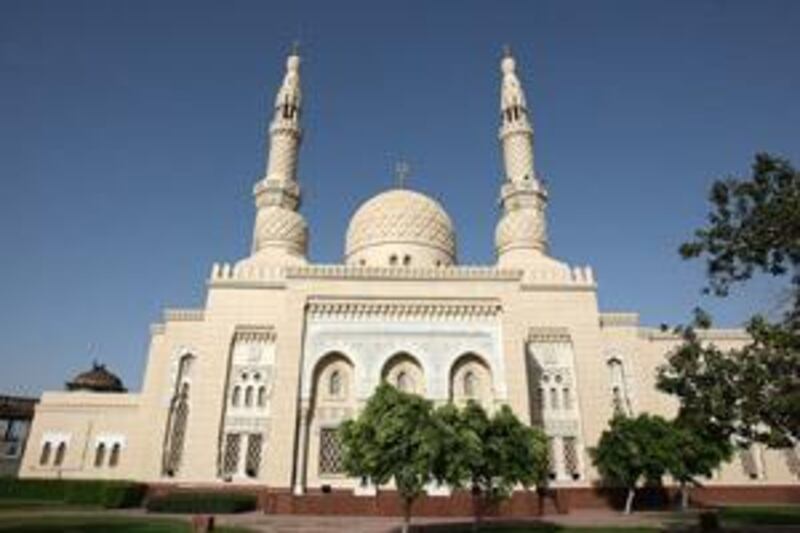DUBAI // Omran al Owais has a vision for his next project: a steel lattice rising from the ground, shaped like a metallic leaf; a glass-roofed underground enclosure, above which a shallow reflective pool casts shadows inside the space and allows maximum natural light to penetrate. But the radical design by the avant-garde architect has its opponents, for one simple reason: it is a mosque. Mr al Owais is proposing nothing less than a complete rethinking of the sacred building. His idea has divided modernists and traditionalists, with the latter saying it is far removed from the "model" which is generally accepted to be the Jumeirah Mosque in Dubai.
Mr al Owais says his primary goal is to reconcile traditional Emirati culture with the country's rapidly modernising urban landscape. Dubai, he says, is evolving faster than the mentality of its people; architecture can bridge the gap, but only if it is allowed to. Rethinking mosque architecture is one way to change that. "The rules here are killing creativity," he says. "We have design rules here that we have to stick to, but they aren't even our traditions. They were taken from other cultures."
Mr al Owais's singular mosque project, envisaged for Za'abeel Park in Dubai, focuses on the prayer space, which he wants to put below ground, under a hill. The roof over the space would be made of glass, covered by a shallow reflective pool casting rays of light on to the worshippers below. Instead of the traditional minarets, a patterned steel screen stands above ground, indicating the presence of a place of prayer.
Adjacent to the prayer space is another room, separated by a one-way mirror, in which a museum exhibits photographs and drawings of traditional mosques and Islamic architecture. Mr al Owais is discussing the project with the municipality, imams and members of the public, though no decisions have been made; nor are they imminent. "The inspiration is a tree: the leaves symbolise hope; the roots symbolise life," he says. "It's the reverse in this mosque. At the end of life, we end up in the grave, where we move to the next life."
According to Dubai Municipality rules, all mosques must follow the Jumeirah model, including domes, minarets and all the other elements of mosque architecture's status quo. But Mr al Owais counters by saying he has done his research. Many of the stated requirements are not examples of traditional Islamic architecture at all, he says. The crescent symbol, for example, was originally used thousands of years ago to show that a building had been converted from a church to a mosque.
Therefore, he continues, it has no religious significance. The dome is patterned after that of the Hagia Sophia in Istanbul, a Byzantine building that was a church from 537AD until 1453, when what was then Constantinople was conquered by the Ottoman Turks. "They want the mosques to look like Jumeirah Mosque," Mr al Owais says. "But a lot of this is Moroccan architecture; it's not even ours. There is a special agenda on how to protect religion, how to protect the mosque. But I'm asking, why are we doing this?
"After 30, 40 years, people will look back on what we've been building here and there won't be anything new. Why don't we do something new? Why don't we modernise? It could put Dubai on the map - in a good way." His controversial views have garnered support from surprising quarters. Abdulla Numan, who works at the municipality's Islamic Affairs Department, looking after the city's 430 official mosques, says there is nothing inherently wrong with Mr al Owais's design.
"It's a good idea. This is beautiful, it's new, it's fantastic," he says, acknowledging that although its unconventional appearance would probably not threaten local culture, the mosque's aesthetic is so ingrained in the local psyche that to change it might pose something of a conundrum. "The problem will probably be the people; with any new idea, some people just won't agree." One example: an imam named Youssef on the other end of the fatwa hotline wondered why the traditional design needed to be updated at all. "All Muslims make designs like Mecca, Medina, Jerusalem," he said.
"That basic design must be found. A new design is not dangerous to local culture, but we must give mosques a special design; they must be traditional, that way people will say, 'that's definitely a mosque'." Again, Mr al Owais says there is no reason to hold that view. "In the Prophet's days they had no minarets; mosques just had to be clean," he says. "Listen, we have prayer spaces in shopping malls now. They have no domes, no minarets. So why are we so conservative?"
Rashed Bukhash, director of the Architectural Heritage Department at the municipality, says the answer to that question is simple: "This design is ultra-modern. Modern design is not accepted here yet. Not now." "Also, the prayer space should not be underground, people will see this as humiliating," he says. "International design is OK for some things. But not for the mosque. We need to maintain some relation to traditional architecture. Especially with mosques."
Mr al Owais says the exhibition space would offer a clear view into traditionally designed mosques. The municipality could not be reached for comment, but regardless of what it decides, Mr al Owais says he will not be deterred. "The resistance gets me even more excited. Not everyone likes it, but a lot of people do." Mr Numan is perhaps one of Mr al Owais's most important allies. Despite his post in one of the most conservative government agencies, Mr Numan says he believes in taking chances, especially with projects that have the potential to enrich the city's culture and urban landscape.
"This is a unique idea," he says. "Maybe it would be good. And if it's a good idea, why not try it?" jhume@thenational.ae






